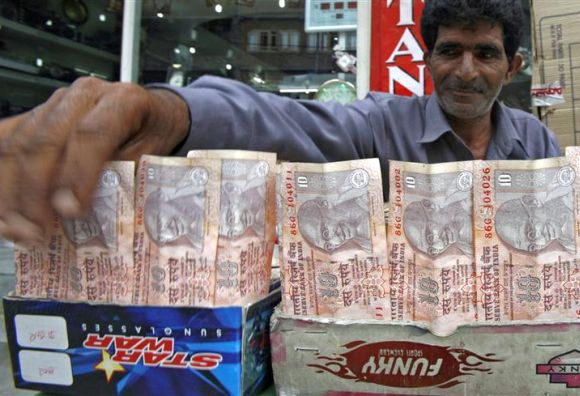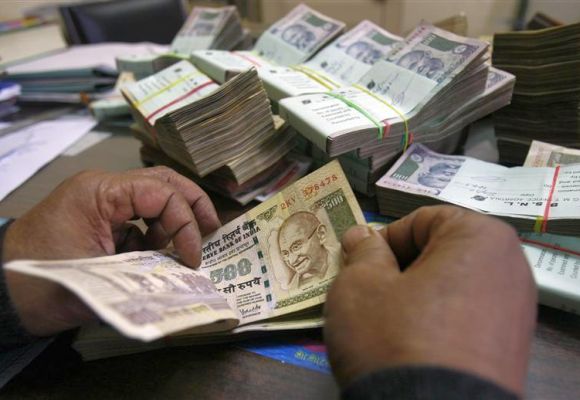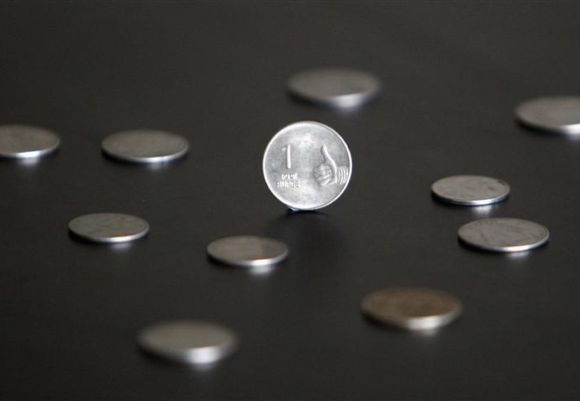Photographs: Reuters Jamal Mecklai
Most importers and exporters are comfortable if the rupee 56-57 against dollar.
There is, of course, no such thing in the real world. Theoretically, we could say that the correct value of the rupee is one that supports growth with low inflation and ensures that both imports and exports do well.
But such an animal is seldom found and, if it does come to life, is dashed rudely in short order.
The closest I could find in recent years was when the rupee was steady (certainly by today's standards) in a range of 44 to 46 over the period from June to August 2011.
…
What is the correct value of the rupee?
Image: A Kashmiri money changer Nissar Ahmad displays newer Indian rupee notes in Srinagar.Photographs: Fayaz Kabli/Reuters
GDP was growing at eight-plus per cent a year, and both exports and imports were on fire (each growing at over 30 per cent a year).
The only failure was inflation, which was quite high, with the wholesale price index (WPI) inflation at over 9 per cent.
Close, but no cigar.
Nonetheless, and particularly since I long ago stopped smoking, let's assume that the exchange rate at that time was a reasonable surrogate for the "correct value" of the rupee.
Let us then adjust that value (of 46 to the dollar) to movements in the DXY since then, the assumption being that all the wildness in the world since then was neatly captured in the value of the dollar index.
…
What is the correct value of the rupee?
Photographs: Reuters
Let us further correct this "still correct extrapolated value" for inflation differentials, the assumption here (quite widely held) being that competitiveness is eroded by high inflation and the currency needs to adjust for that.
Running this very simple arithmetic gives us "today's correct with all the disclaimers" value of the rupee as 56-57, much more reasonable than some of the grotesque levels being bandied about by some analysts and economists.
Judging from anecdotal straw polls, most exporters would be quite happy with this level, provided they didn't have to deal with this unmanageable volatility.
On the short side, too, it appears that the 56 level would be acceptable to companies with imports - more so now that they have seen 60 - at current domestic price levels.
…
What is the correct value of the rupee?
Photographs: Reuters
A senior corporate leader, whose group is a large importer, has gone on record saying that the Reserve Bank of India (RBI) should intervene to bring the rupee-dollar rate down to 56.
Equally, companies that compete with Chinese imports have reported that 56 or 57 is a sweet spot from a competitiveness standpoint.
Unfortunately, this is all just theoretical drivel.
The reality is that the rupee almost touched 60 (on June 20) and remains hostage to global events.
True, the market may have over-reacted to US Federal Reserve Chairman Ben Bernanke's comments on June 19, as many pundits are asserting, but I have much more faith in the market than in pundits.
…
What is the correct value of the rupee?
Photographs: Reuters
If the US non-farm payrolls on July 5 turn out to be huge - say, the economy added 300,000 jobs - the US bond market would certainly fall out of bed all over again and all its emerging market lovers would be trampled underfoot.
Even if this does not happen, there are many signals that the world could be entering yet another phase of risk aversion.
The continuing collapse of gold (I told you $1,200; now I'm saying $900 - remember you read it here first); the sudden 7 per cent dive in the Nikkei a week ago; protests in many of brighter stars of the emerging markets firmament. Any or all of these could be pointers to another sudden bout of market terror.
Now, I'm not asserting any of these - except the gold forecast - but if this were to pan out, the rupee could sink through 60 without a ripple (this was written last weekend) and God knows where it would come up for air.
The point of risk management, for a company or a government, is to think about scenarios that could end in tears and plan - or act - in advance.
…
What is the correct value of the rupee?
Photographs: Reuters
The good news is that the government is taking some steps - the announcements by the Cabinet Committee on Economic Affairs on Friday were a good beginning, and there is apparently more to come.
I would, of course, prefer more. Waiting for a crisis to unfold is much worse than anticipating one and acting preventively.
Rather than carrying on about how we have things under control and have all the instruments we need, the government and the RBI should put on a sombre face, announce a crisis and use the cover to take steps that everybody knows need to taken - slash subsidies further (a much better than promised budget deficit would certainly excite investors); permit banks to open gold savings accounts (we have 35,000 tonnes of gold in the country; attracting even 2 per cent of this could reduce our gold import bill by 70-80 per cent); and cut interest rates by 1 per cent.
All hell will doubtless break loose, and the rupee may well still fall if global forces so demand. But growth will kick upwards and it may also turn out to be the United Progressive Alliance's only chance of returning to power.
jamal@mecklai.com








article